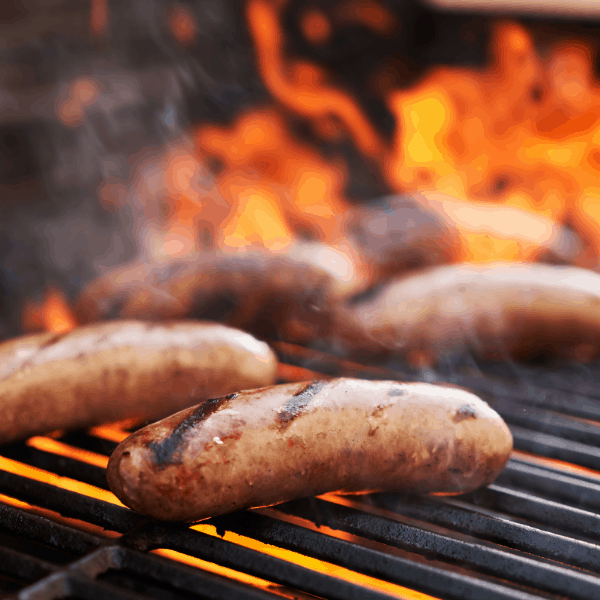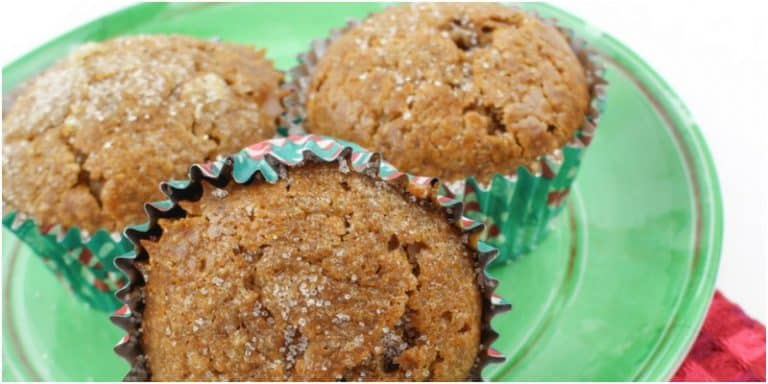Experience a delicious mixture of flavors with Browned Butter, Pumpkin, and Bacon Linguine, a dish crafted with culinary expertise. Combining the richness of browned butter, the silkiness of pumpkin, and the savory allure of bacon, it transcends ordinary pasta.
Each bite tantalizes with layers of nutty, sweet, and savory notes. It’s not just a meal; it’s a gourmet adventure that captures the essence of carefully chosen ingredients. This dish embodies the latest culinary insights and is perfect for entertaining dinners or occasions. Elevate your pasta experience and savor every bite of this symphony on a plate.
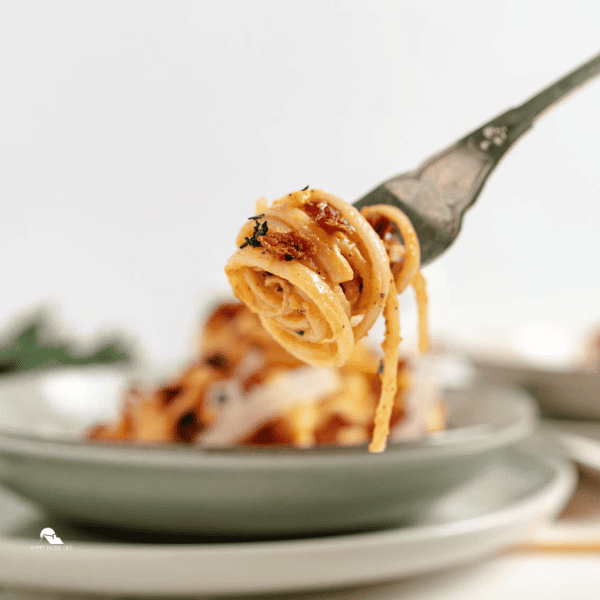
What is the difference between spaghetti and linguine?
Spaghetti and linguine, both belonging to the vast family of pasta, exhibit notable differences in their shape, thickness, and customary applications. Spaghetti is recognized for its long, thin, cylindrical structure with a round cross-section that can vary in thickness.
Conversely, linguine, another long and thin pasta, is characterized by a flatter and wider profile, featuring an elliptical, flattened shape and a thickness akin to fettuccine. These structural disparities extend to texture, with spaghetti’s roundness imparting a smooth feel, while linguine’s flatter design provides a broader surface area that influences how sauces adhere to the pasta.
Their distinctive features are further underscored by traditional pairings—spaghetti commonly accompanies a range of sauces, from tomato-based to oil-based, in dishes like spaghetti bolognese, while linguine finds its place with seafood-based, clam or lighter oil-based sauces, aligning with its wider, flatter form.
In terms of versatility, spaghetti’s adaptability shines through in a myriad of dishes, from simple classics to more elaborate creations, while linguine’s shape and texture make it particularly suited for sauces with a lighter or seafood focus.
In essence, the choice between spaghetti and linguine hinges on personal taste preferences and the specific culinary context, with each pasta variety contributing its own unique character to the gastronomic experience.
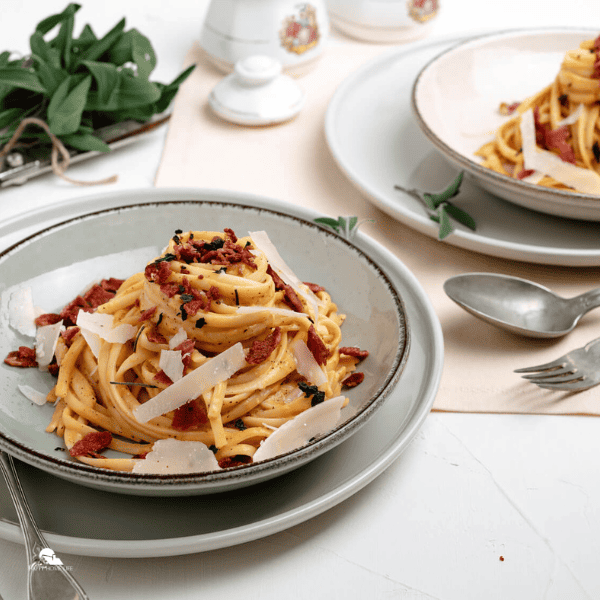
What’s the difference between fettuccine and linguine?
Fettuccine and linguine are both popular types of pasta, but they have distinct characteristics that set them apart. Fettuccine is a broad, flat pasta, similar to a ribbon, and is known for its width, which is typically wider than other flat pasta varieties like tagliatelle. Its width allows it to hold up well to creamy and hearty sauces, making it a favorite for dishes like Fettuccine Alfredo.
On the other hand, linguine is a long, flat pasta that is narrower and more elliptical in shape compared to fettuccine. The slender profile of linguine makes it a versatile choice, pairing well with a variety of sauces. It’s often used in seafood dishes or lighter oil-based sauces, allowing the flavors to coat the pasta evenly.
Ultimately, the choice between fettuccine and linguine depends on the desired texture, sauce, and the overall culinary experience one is aiming for. Whether you’re craving a robust, creamy dish or a lighter, seafood-infused meal, these pasta varieties offer diverse options to suit different tastes and preferences.
Why use linguine instead of spaghetti?
Opting for linguine over spaghetti can enhance your culinary experience due to several notable differences between these two pasta varieties. Linguine, characterized by its flatter and wider shape, provides a different texture and surface area than cylindrical and round spaghetti.
This distinction makes linguine particularly well-suited for certain types of sauces, especially those with a lighter or seafood-based profile.
The broader shape allows sauces to cling more effectively to the pasta, creating a harmonious blend of flavors. Linguine’s association with Ligurian cuisine also suggests pairing it with seafood-based sauces or clam sauces, taking advantage of its ability to hold up to chunkier mixtures.
Ultimately, the choice between linguine and spaghetti boils down to personal preference, the desired sauce, and the specific culinary creation you have in mind.
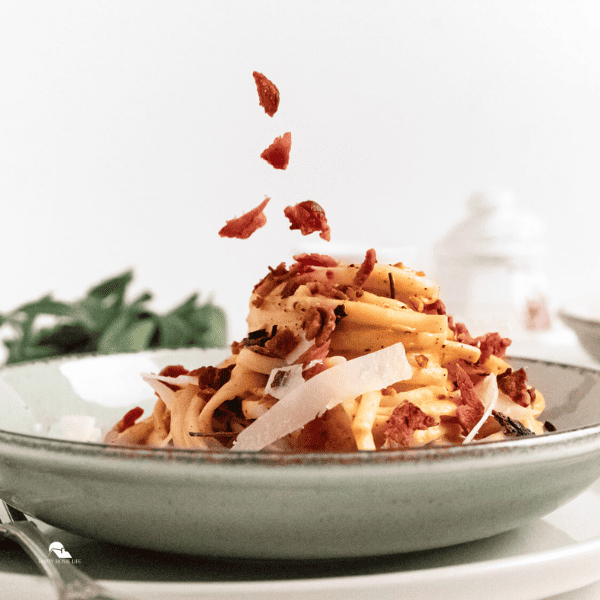
How is linguine served?
Linguine, a versatile pasta with its flattened, elliptical shape, can be served in various delightful ways. One common and classic preparation involves pairing linguine with seafood-based sauces. The flatter shape of linguine allows it to cradle the flavors of dishes like linguine alle vongole (with clams) or linguine ai frutti di mare (seafood medley).
The broad surface area also makes it an excellent choice for lighter oil-based sauces, where the sauce can coat the pasta evenly. Linguine aglio e olio, a simple yet flavorful dish with garlic and olive oil, is a prime example.
Additionally, linguine works well with sauces incorporating fresh herbs, vegetables, or even a light tomato sauce. The versatility of linguine makes it a canvas for various culinary creations, ensuring a satisfying dining experience that highlights the pasta’s unique shape and texture.
Whether enjoying it with a classic seafood sauce or exploring more innovative combinations, linguine’s adaptability lends itself to a diverse array of delicious dishes.
Make Ahead Tip:
You can make Browned Butter, Pumpkin, and Bacon Linguine ahead of time. Consider crafting a double batch of the exquisite browned butter, allowing you to freeze portions in ice cube trays for future use. This ingenious method saves time and ensures that browned butter’s rich, nutty essence is always at your fingertips.
When the craving strikes, simply thaw the desired number of browned butter cubes, effortlessly bringing a touch of gourmet flair to your linguine creation without the need for immediate preparation. This make-ahead tip unlocks a realm of culinary convenience, allowing you to indulge in this delectable dish whenever the mood strikes.
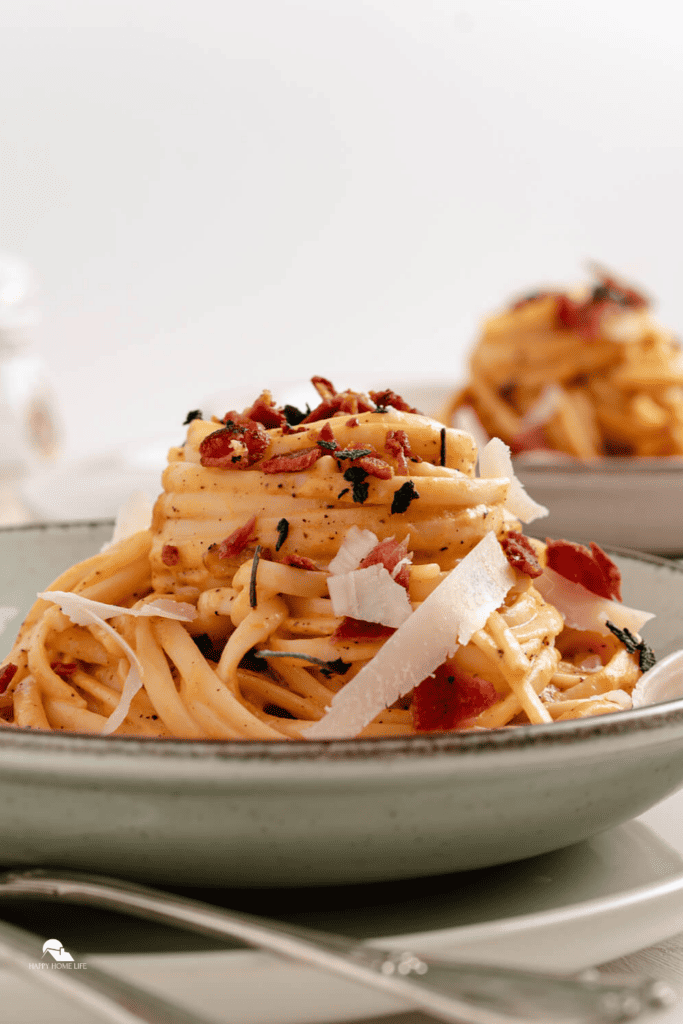
What are the ingredients for browned butter, pumpkin, and bacon linguine?
Prepare for 10 minutes and cook for 25 minutes to yield 4 servings.
- Bacon
- Linguine – cooked according to package instructions
- Butter – cut into 6 even pieces
- Shallots – diced
- Garlic cloves – minced
- Fresh sage leaves – chopped
- Pure pumpkin puree – canned or homemade
- Heavy cream
- Black pepper – to taste
- Parmesan cheese – shaved into large strips with a potato peeler

How to make Spicy Tuna Cucumber Bites?
- Cooking Bacon and Sage: In a big skillet, cook bacon until golden, then set it aside. Crisp fresh sage in bacon drippings for 3-4 mins, placing it beside bacon. Keep the pan for the next step in this delicious journey.
- Preparing Linguine: Follow the package instructions to prepare linguine. Ensure proper draining without rinsing to retain its warmth.
- Browning Butter: After crisping bacon in the skillet, wipe it, add butter, and heat over medium heat until melting. Reduce to medium-low, cooking for 5-6 minutes until the butter turns brown and foamy. Stir occasionally to prevent burning. This meticulous process enriches the butter with a deep, nutty flavor, enhancing its overall taste.
- Adding Aromatics and Pumpkin Sauce: Incorporate shallots and garlic into the browned butter, cooking until fragrant for 2-3 minutes. Integrate pumpkin puree and heavy cream, continuing to cook until heated through for an additional 2-3 minutes.
- Combining Linguine with Pumpkin Sauce: Integrate linguine into the buttery pumpkin sauce. Then, toss thoroughly to coat the pasta with a flavorful sauce. Taste and season with black pepper, adjusting salt as needed, considering the forthcoming addition of bacon and parmesan.
- Assembling the Dish: Break bacon into sizable pieces and crumble sage. Plate the linguine, twirling it onto plates, and crown it with crispy bacon, sage, and shavings of parmesan. Dive into a culinary symphony where the rich, savory, and crisp elements harmonize. Enjoy!
Browned Butter, Pumpkin, and Bacon Linguine
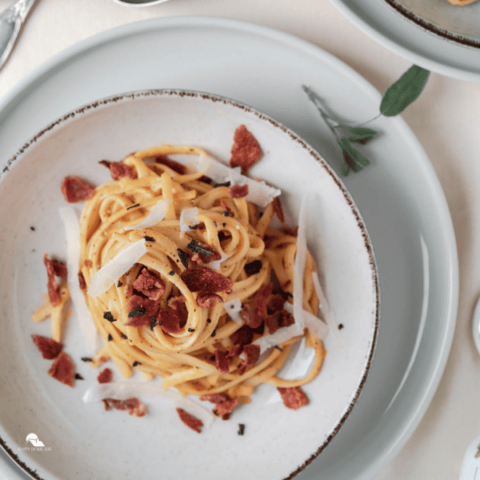
Savor the essence of fall with our exquisite Browned Butter, Pumpkin, and Bacon Linguine. A symphony of flavors that captures the warmth and richness of the season.
Ingredients
- 4 slices bacon
- 12 oz. linguine, cooked according to package instructions
- 6 T. butter, cut into 6 even pieces
- 3 shallots, diced
- 2 garlic cloves, minced
Instructions
- Cook bacon in a large light-colored skillet over medium heat until crispy. Transfer to a plate lined with paper towel and set aside. Cook fresh sage leaves in bacon drippings until crispy, 3-4 minutes. Set aside on plate with bacon strips. Reserve pan for Step 3.
- Prepare linguine according to package directions. Drain well, but do not rinse. Keep pasta warm.
- Wipe the skillet you used to cook bacon with a paper towel. Add butter. Cook gently over medium heat until the butter begins to melt. Once melted, reduce heat to medium-low and cook until brown and starts to foam, 5-6 minutes. Watch carefully and stir occasionally so butter does not burn.
- Add shallots and garlic to the browned butter and cook until the veggies become fragrant, 2-3 minutes.
- Stir in pumpkin puree and heavy cream and continue cooking until heated through, 2-3 minutes.
- Add linguine to the buttery pumpkin sauce. Toss to coat with sauce. Taste and season with black pepper, to taste. (Salt is not generally required due to the addition of bacon and parmesan in next step).
- Break bacon into large pieces. Crumble sage.
- Twirl pasta onto plates and top with crispy bacon, sage, and parmesan shavings. Enjoy!
Notes
Make Ahead Tip: Prepare a double batch of browned butter and freeze in ice cube trays for later use.
Nutrition Information:
Yield:
4Serving Size:
1Amount Per Serving: Calories: 619Total Fat: 37gSaturated Fat: 22gTrans Fat: 1gUnsaturated Fat: 13gCholesterol: 103mgSodium: 610mgCarbohydrates: 56gFiber: 6gSugar: 7gProtein: 17g
These nutritional calculations might not be accurate. Please speak with a licensed nutritionist to assist you.


